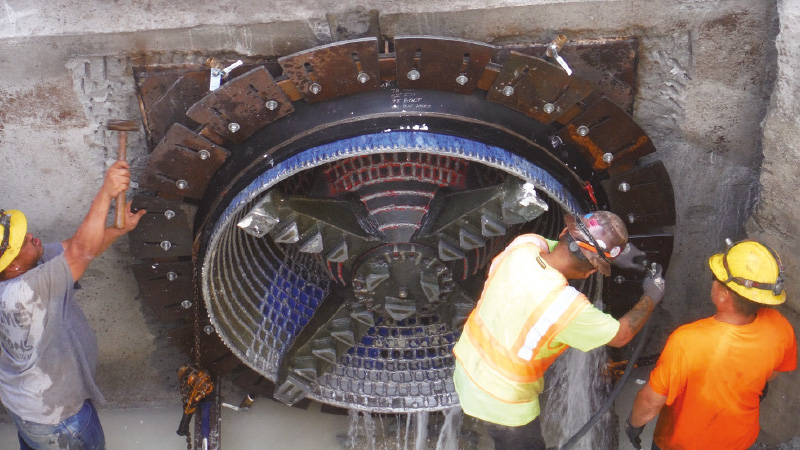CONTRIBUTION TO THE WELL-BEING AND PEOPLE AND COMMUNITIES
Adequate sewer systems and wastewater management plays a vital role in sanitation and prevention of disease for the people and communities of Hawaii.
The purpose of this project was to comply with the Consent Decree jointly executed in year 2010 by the United States Environmental Protection Agency, the State of Hawaii, and the City and County of Honolulu. The Consent Decree mandates the City to make improvements to the municipal sewer system and sewer facilities in order to reduce or avoid sewage spills and overflows. The City has completed various sewer improvements projects to comply with the Consent Decree. This subject project is but one of the several different projects constructed for compliance with the Consent Decree and for the benefit of the people of Hawaii.
RESOURCEFULNESS IN PLANNING AND SOLVING DESIGN CHALLENGES
This project originally intended to address a consent decree project to upgrade the Awa Street Wastewater Pump Station (WWPS) by expanding its capacity. Showing the resourcefulness of the project team during the planning phase it was identified that redirecting wastewater flow by constructing a new truck sewer along Waiakamilo Road, from North School Street to Nimitz Highway, would address three separate consent decree projects. This diversion of wastewater lightened the load on the Awa WWPS and eliminated the need for improvements to expand capacity. This diversion also addressed hydraulic deficiencies in two sewer lines (approx. 3,700 linear feet) located immediately upstream of the Awa WWPS. These deficiencies were to be addressed in a separate consent decree project called Dillingham Boulevard – Iwilei Relief Sewer. Additionally, the trunk sewer diversion addressed hydraulic deficiencies in 34,300 linear feet of 6 to 30-inch sewer lines. These deficiencies were to be addressed under a separate consent decree project, Chinatown Sewer Rehabilitation. The project team’s resourcefulness and problem-solving during planning found a single solution to address three separate consent decree projects.
This single solution also came with design challenges that needed to be solved. To accomplish this diversion, the existing wastewater flow direction needed to be reversed along Dillingham Boulevard, Colburn Street, and the makai ends of Kohou Street and Waiakamilo Road. In addition to the challenge of reversing sewer flows, the project involved constructing approximately 10,500 linear feet of new 8-inch to 54-inch diameter gravity sewer lines along Waiakamilo Road and Houghtaling Street, and along several of the connecting side streets. Design challenges included limited working area, high vehicular and pedestrian usage, and numerous existing utilities in the project area. To minimize impacts during construction, the trunk sewer was installed using microtunneling methods.
PIONEERING IN USE OF MATERIALS AND METHODS
This project encountered a very challenging waterline crossing that required design and construction methods that were not typical. The 54-inch trunk sewer’s ability to adjust vertically was extremely limited and at the intersection of Waiakamilo and Dillingham Boulevard, the microtunneling would pass very close to a 42-inch waterline. This 42-inch waterline is a major component to Honolulu’s water supply and could not be out of service for no more than 48-hours. This 48-hour timeframe included demolition of the existing pipe and establishing the new connections, which required special couplings along with specialized welders. To accomplish this task, the replacement portion of the waterline was fully assembled at an off-site location at Sand Island. This required an innovative design of a special steel frame that held multiple 42-inch ductile iron fittings in place, fully assembled. This steel frame was also designed to resist the massive thrust pressures the assembly experienced once the waterline was live, and prior to a concrete encasement fully curing. The steel frame also allowed for two cranes to hoist the entire assembly to place it into the prepared trench. There was also the challenge of ensuring the entire assembly, including the piping, steel frame, and transport vehicle did not exceed the capacity of the bridge infrastructure along the transit route. This 48-hour effort required massive amounts of planning with various stakeholders and incredible timing. The coordination effort included relocations and temporarily de-energizing of overhead power lines and telecommunication lines, water shutoffs and draining, and a 48-hour full roadway closure at the intersection.
INNOVATIONS IN CONSTRUCTION
Microtunnel installation and construction methods are well documented in Hawaii. Though that does not mean that the project team did not face challenges that required innovative solutions. Unforeseen fiber optic traffic single lines were encountered during construction. This discovery threatened the projects ability to meet the consent decree deadline. Through collaboration, the fiber optic lines were allowed to be temporarily installed overhead during the installation of the new trunk sewer and then restored to its original configuration after completion. Even the microtunneling operation, though used multiple times in Hawaii, encountered unforeseen challenges that require the project team to adapt. Numerous boulders were encountered during various microtunneling drives and emergency shafts were required to remove the boulders and make repairs to the microtunnel boring machine (MTBM). Metal debris was also encountered, which required repair to the MTBM and slurry pumps. The MTBM even required replacement during the project due to damage suffered and numerous repairs. A new MTBM was shipped from Japan to complete the project and an emergency retrieval shaft was required to remove the old MTBM.
MINIMIZATION OF IMPACT ON PHYSICAL ENVIRONMENT
Due to the location of the project site, there were concerns that contaminated media (i.e. soil and groundwater) may be encountered during the construction phase of the project so a Construction Environmental Hazard Management Plan was prepared to establish procedures for the handling of contaminated media that could pose a hazard to human health and the environment. An off-site soils management area was also provided at the Sand Island Wastewater Treatment Plant for use by the Contractor to stockpile and/or dewater soils which originated from the project. This media was tested prior to transport to ensure the material did not exceed Project Action Levels. To allow the use of this off-site a Solid Waste Management Permit was also obtained.


